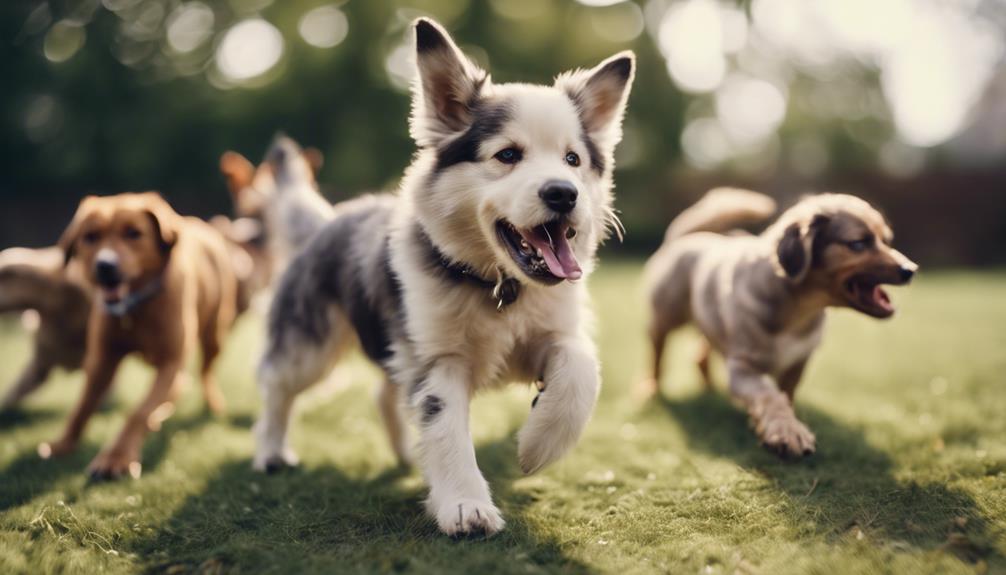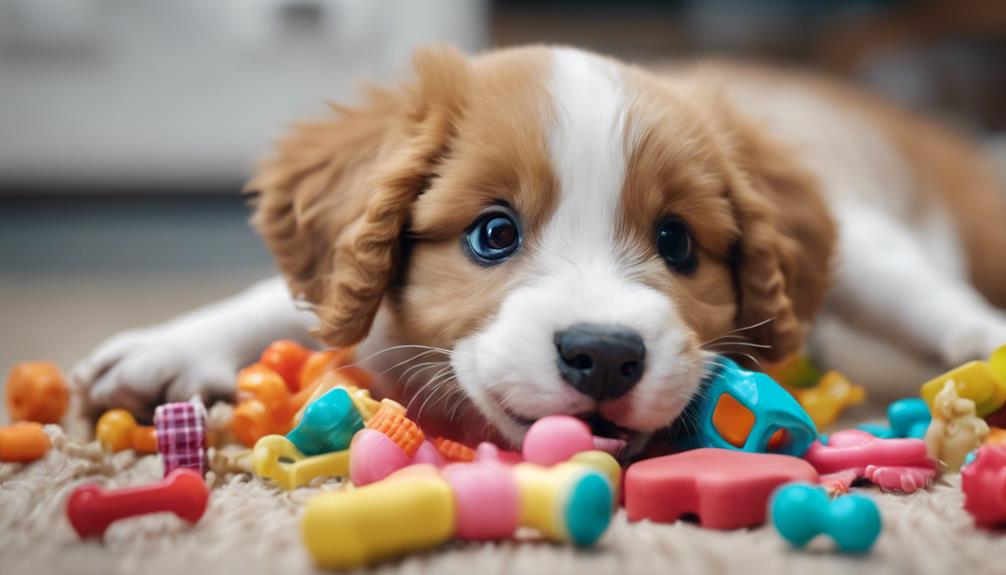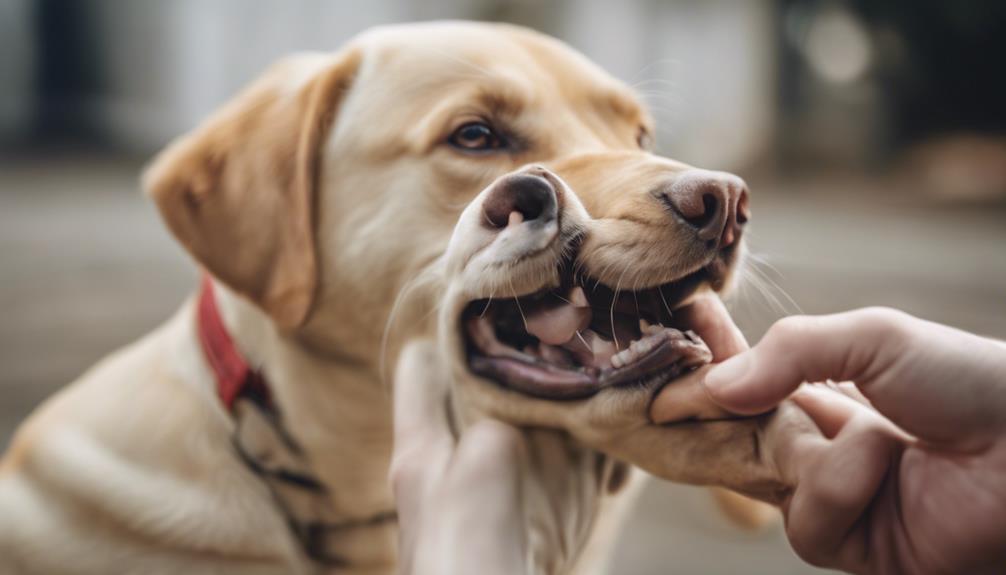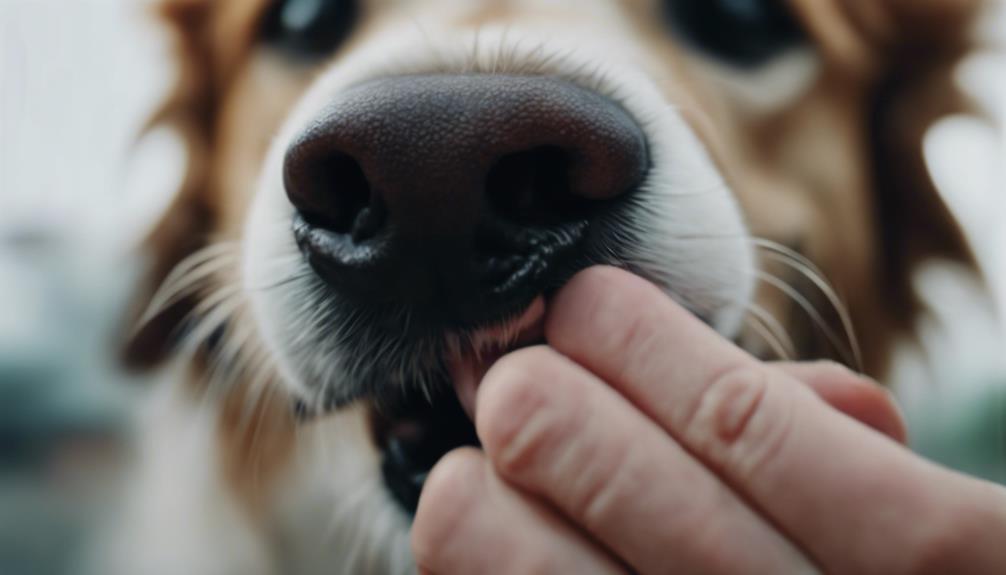In the intricate world of canine behavior, the act of dogs nibbling on humans often sparks curiosity and contemplation among pet owners. Understanding the underlying motives behind this behavior goes beyond mere surface observation; it delves into a realm where communication, emotions, and companionship intertwine.
By uncovering the rationale behind why dogs engage in nibbling behaviors, a deeper connection between humans and their furry companions emerges, revealing a tapestry of insights that can enrich the human-canine bond.
Key Takeaways
- Nibbling in dogs is often due to developmental stages like teething and breed-specific behaviors.
- Arousal during play can lead to nibbling behavior as a form of excitement expression.
- Understanding dog communication and behaviors helps decipher reasons behind nibbling tendencies.
- Professional help is advised for intense nibbling cases to address any underlying issues effectively.
Nibbling Vs. Biting Distinction
The distinction between nibbling and biting in dogs is crucial for understanding canine behavior and ensuring appropriate responses to their actions. Nibbling typically involves minimal teeth pressure, lacking aggression or fear, while biting is characterized by more intense teeth pressure that may result in harm. Understanding this difference is essential for interpreting a dog's intentions and emotions accurately.
Nibbling can stem from various reasons such as developmental stages like puppy teething, breed-typical behaviors, arousal during play, or grooming habits. It is important to observe the context in which the behavior occurs to determine whether it is innocuous or requires intervention. Seeking professional help is advisable for cases where nibbling escalates to biting with significant force.
Seeking Professional Help
Seeking professional guidance is recommended for addressing escalating nibbling behavior in dogs. Professional help can provide tailored strategies and interventions to manage and modify this behavior effectively.
When seeking assistance for your dog's nibbling behavior, consider the following:
- Consult with a certified dog behaviorist or trainer specializing in behavior modification techniques.
- Conduct a thorough behavioral assessment to identify triggers and underlying causes of the nibbling behavior.
- Implement a personalized training plan focusing on positive reinforcement and redirection techniques to address the behavior effectively.
Developmental Stage Reasons

Understanding the developmental stage reasons behind a dog's nibbling behavior sheds light on the natural tendencies linked to their growth and exploration. During the developmental stages of a puppy, teething and exploring play significant roles in their behavior. Here is a breakdown of how these developmental aspects contribute to a dog's nibbling behavior:
| Developmental Stage | Description | Impact on Nibbling |
|---|---|---|
| Teething Stage | Puppies teethe around 4 to 6 months old. | Teething prompts increased chewing behavior. |
| Chewing aids in exploration and learning. | ||
| Exploratory Behavior | Puppies use their mouths to explore the environment. | Nibbling is a way for puppies to learn about the world. |
Teething and Exploration
In the early stages of a dog's development, the process of teething and exploration plays a crucial role in shaping their behavioral tendencies. Teething, typically occurring around 4 to 6 months of age, prompts increased chewing behavior as puppies seek relief and aid in their exploration and learning process. During this stage, exploration through mouthing objects and individuals helps puppies understand their surroundings and interact with the environment effectively.
Teething and Exploration Insights:
- Teething aids in relieving discomfort and facilitates learning.
- Chewing behavior increases during the teething stage.
- Exploration through mouthing assists puppies in understanding their environment.
Breed-Typical Nibbling Behaviors

During the early stages of a dog's development, breed-specific tendencies can influence their inclination towards nibbling behaviors. Certain breeds exhibit distinct behaviors related to their historical roles or purposes. For instance, herding dogs like Australian cattle dogs may display nipping behaviors as part of their herding instinct. Labrador retrievers, bred for retrieving, might have a natural inclination towards mouth-related activities. Understanding these breed-specific tendencies can provide valuable insights into why some dogs exhibit more nibbling behaviors than others. Below is a table highlighting examples of breed-typical nibbling behaviors:
| Breed | Nibbling Tendency | Historical Role |
|---|---|---|
| Labrador Retriever | Moderate nibbling tendencies, linked to retrieving tasks | Retrieving and carrying objects |
| Border Collie | High propensity for nipping behaviors, used in herding | Herding livestock |
| Dachshund | Mild nibbling tendencies, related to hunting instincts | Digging and hunting small prey |
Arousal During Play
Dogs may exhibit increased nibbling behavior as a form of expression and excitement during play sessions. This behavior is often a result of heightened arousal levels and can be a way for dogs to communicate their enthusiasm. When engaging in play, dogs might resort to gentle nibbling as a means of interaction and enjoyment.
This nibbling behavior can serve as a playful gesture, reinforcing the bond between the dog and its human companion. To better understand this behavior, consider the following points:
- Nibbling during play can indicate heightened excitement levels.
- It may be a form of attention-seeking behavior.
- Positive reinforcement can reinforce this behavior as a means of expressing joy and engagement.
Fear or Conflicted Emotions

Amidst playful interactions where dogs exhibit heightened nibbling behavior as an expression of excitement, it is essential to consider how fear or conflicted emotions may influence their actions. Dogs may resort to nibbling when experiencing fear or conflicting emotions, using this behavior as a coping mechanism to alleviate stress or uncertainty. Understanding these underlying emotions can help in addressing the root cause of the behavior and providing appropriate support and training.
| Fear or Conflicted Emotions | Influence on Nibbling Behavior |
|---|---|
| Fear | Nibbling as a coping mechanism |
| Conflicted emotions | Stress relief through nibbling |
| Uncertainty | Seeking comfort through behavior |
| Anxiety | Expressing emotional distress |
| Traumatic experiences | Nibbling as a response to past events |
Grooming Behavior Insights
In the realm of canine behavior, grooming behavior in dogs serves as a vital aspect of their social and self-maintenance repertoire.
- Self-Cleaning Rituals: Dogs groom themselves to maintain cleanliness and hygiene, licking their fur to remove dirt and debris.
- Social Bonding: Mutual grooming among dogs reinforces social bonds within a pack or family unit, promoting trust and cooperation.
- Comfort and Relaxation: Grooming behavior can have a calming effect on dogs, reducing stress and anxiety levels.
Understanding the significance of grooming behavior provides insight into the intricate ways dogs interact with their environment and each other, highlighting the importance of these actions beyond mere physical maintenance.
Teething Stage Details

During the teething stage, puppies typically engage in increased chewing behavior to aid in their exploration and learning processes. This stage usually occurs when puppies are around 4 to 6 months old. Teething prompts the need for chewing as a way to alleviate discomfort caused by new teeth coming in and also helps strengthen their jaw muscles.
The urge to chew may lead puppies to gnaw on various objects, including furniture, shoes, and even hands. Providing appropriate chew toys can help redirect this behavior and protect household items from damage. Understanding and managing this teething stage is crucial in ensuring the development of healthy dental habits in puppies as they transition into adulthood.
Chewing for Exploration
Exploring their surroundings through chewing is a natural behavior for puppies as they develop their understanding of the world around them. This behavior serves as a way for them to gather information about their environment, objects, and even people.
- Chewing allows puppies to experience different textures and tastes.
- It helps them learn about the hardness or softness of various items.
- Puppies use chewing as a means of interacting with and understanding the world around them.
Through this exploratory behavior, puppies are able to satisfy their curiosity and gain valuable knowledge about their surroundings. This chew-focused exploration is an essential part of their developmental process.
Breed-Specific Nibbling Traits

Puppies of certain breeds exhibit distinctive nibbling tendencies rooted in their genetic predispositions and historical roles. For example, Labrador retrievers, bred for retrieving, may show a gentle nibbling behavior as part of their retrieving instinct.
Herding dogs like Australian cattle dogs might display nipping tendencies as a herding trait. Similarly, breeds with a history of hunting or tracking may exhibit nibbling behavior as a remnant of their hunting instincts.
Understanding these breed-specific traits can help owners appreciate their dog's natural inclinations and provide appropriate outlets for these behaviors. By recognizing and respecting these inherent tendencies, owners can better manage and channel their dog's nibbling behaviors in a constructive manner.
Instinctual Nibbling Behaviors
Rooted in their genetic makeup, dogs may exhibit instinctual nibbling behaviors that reflect their historical roles and innate tendencies. This behavior can be traced back to their ancestors' actions, where nibbling served specific purposes essential for survival and daily activities.
When observing dogs engaging in instinctual nibbling behaviors, it is important to consider the following:
- Hunting and Prey Drive:
- Some dogs may nibble as a way to simulate hunting behaviors.
- Communication and Social Bonding:
- Nibbling can be a form of social interaction and bonding among dogs.
- Maternal Care and Grooming:
- Nibbling behaviors can also mimic maternal care and grooming actions within a pack or family unit.
Arousal Behavior Triggers

When considering arousal behavior triggers in dogs, it is crucial to understand the various stimuli that can lead to nibbling actions. Arousal behavior, often seen during play or moments of excitement, can manifest in dogs through nibbling as a form of expression. This nibbling behavior can also serve as a means for seeking attention from their owners or other animals. Understanding these triggers is essential for interpreting and managing a dog's behavior effectively.
| Arousal Behavior Triggers | Examples |
|---|---|
| Playfulness | Chasing a ball, engaging in tug-of-war |
| Attention-Seeking | Nibbling to elicit a response from the owner |
| Excitement | Meeting new people or animals, going for walks |
| Social Interaction | Playing with other dogs, interacting with family members |
Positive Reinforcement Impact
Understanding how positive reinforcement impacts a dog's behavior is crucial in shaping and reinforcing desirable actions, including addressing nibbling tendencies triggered by arousal behavior. Positive reinforcement involves rewarding desired behaviors to increase the likelihood of their repetition.
In the context of nibbling, this method can effectively redirect a dog's attention and encourage alternative, non-nibbling behaviors. To utilize positive reinforcement effectively in addressing nibbling tendencies, consider the following:
- Consistently reward your dog for gentle interactions without nibbling.
- Use treats or toys to redirect their focus when they start nibbling.
- Avoid inadvertently reinforcing nibbling by withdrawing attention or redirecting focus when it occurs.
Can a dog’s nibbling behavior be related to their understanding of language?
Some dog owners believe that their dogs and similar-sounding words understand language to the point where their nibbling behavior can be related to specific words or commands. While there is some evidence to suggest that dogs can pick up on certain words, their nibbling behavior is more likely related to attention-seeking or playfulness rather than language comprehension.
Conclusion
In conclusion, understanding the reasons behind dogs' nibbling behaviors is crucial for fostering a deeper connection with our canine companions.
By recognizing the distinctions between nibbling and biting, exploring developmental stages such as teething, and acknowledging breed-specific tendencies, pet owners can interpret their dogs' communication cues and emotional expressions more effectively.
By addressing arousal triggers and providing positive reinforcement, individuals can enhance the bond between themselves and their furry friends, promoting a harmonious and enriching relationship.




